History of Nizhny Novgorod
Foundation of Nizhny Novgorod
During the military campaigns of the Russian princes against the Volga Bulgaria, the place where the Oka River flows into the Volga was used as a gathering point for the Murom and Suzdal troops. In 1220, Grand Duke Yuri Vsevolodovich (the grandson of Prince Yuri Dolgoruky, the founder of Moscow) conducted a successful campaign against the Bulgars. After it, he “decided to strengthen this important place for Rus” and founded a town at the mouth of the Oka.
It was named Novgorod, which literally means “new town”. Later, the adjective “nizhny” (“lower”) was added to the name of the town in the Russian annals. This was probably done in order to distinguish it from the town of Novgorod (present Veliky Novgorod) and other Novgorods that existed at that time.
The founding of Nizhny Novgorod was the beginning of an active expansion of Russian influence in the Mordovian lands. Two white-stone churches were built in the fortress, including the Cathedral of the Archangel (1227) - evidence of the special role that the town had in the system of lands of Vladimir-Suzdal Rus. However, the Mongol invasion stopped further development.
Information about Nizhny Novgorod of the 13th century is extremely scarce. But it is known that after the invasion it revived relatively quickly. Nizhny Novgorod is constantly mentioned in Russian chronicles as a major political and economic center of North-Eastern Rus and a spiritual center of Orthodoxy in the Volga region. The town was often the object of conflicts between Moscow and Tver.
In 1392, the Moscow prince Vasily I received a jarlig for the Nizhny Novgorod Principality and captured Nizhny Novgorod. The final annexation of Nizhny Novgorod to the possessions of Moscow took place in the late 1440s.
More Historical Facts…
Nizhny Novgorod in the 16th-18th centuries
Under Ivan III and Vasily III, the town played the role of a border post and was a gathering place for military campaigns against the Kazan Khanate. In 1508-1515, the stone kremlin was built. After the capture of Kazan by Ivan the Terrible, the border role of Nizhny Novgorod became insignificant. At the same time, Nizhny Novgorod became the center of trade between Russia and the East and a large shipbuilding center.
In September 1611, during the Time of Troubles, the Second People’s Militia was organized in Nizhny Novgorod to fight the Poles who were able to establish control over Moscow. The militia consisted of detachments of townspeople, peasants of the central and northern regions of the Tsardom of Russia. The leaders were the Nizhny Novgorod merchant Kuzma Minin and Prince Dmitry Pozharsky (the monument to them is installed on Red Square in Moscow). In October 1612, the militia was able to completely liberate Moscow.
In the 17th century, a schism occurred in the Orthodox Church under Patriarch Nikon. It led to the formation of numerous settlements of Old Believers in the vicinity of Nizhny Novgorod. In 1695, during his Azov campaign, Peter I arrived in Nizhny Novgorod. In 1719, as a result of his administrative-territorial reforms, the town became the center of a separate Nizhny Novgorod Governorate. In 1722, setting off on the Persian campaign, Nizhny Novgorod was again visited by Peter I. Here he celebrated his 50th birthday.
In 1767, Nizhny Novgorod was visited by Empress Catherine II. During her stay in the town, she met the famous local mechanic and inventor Ivan Kulibin. After her visit, a new regular town plan was approved. The first town theater was built in 1798. Later, it became known as Nikolaevsky, in honor of Emperor Nicholas I.
Nizhny Novgorod in the 19th century
At the turn of the 18th and 19th centuries, Nizhny Novgorod became a major scientific and cultural center of the Russian Empire. In 1811, the population of Nizhny Novgorod was about 14,400 people. In 1817, the Makaryev Fair, the largest fair of the Russian Empire, was moved to the village of Kunavino (one of the districts of today’s Nizhny Novgorod). Before that, it was organized every year near the Makaryevsky Monastery, which burned down a year earlier. From that time on, it began to be called the Nizhny Novgorod Fair. Thanks to it, the rapid economic development of the town and adjacent villages began.
After Emperor Nicholas I visited the town in 1834, the large-scale reconstruction of Nizhny Novgorod began. In 1847, a water supply system appeared in the town and the first fountain was built. Private buildings in the Nizhny Novgorod Kremlin were demolished and new administrative buildings appeared in their place. A lot of new buildings, streets, boulevards, and gardens were built.
In 1849, a large industrial enterprise was founded in the village of Sormovo (another district of today’s Nizhny Novgorod). Later, it became known as the Sormovo plant. It was producing river steamers, various railway cars, steam locomotives, and trams. Thanks to the plant, Sormovo soon turned into a large village of workers. In 1862, the construction of the Moscow-Nizhny Novgorod railway was completed. In 1863, the population of the city was 41,500 people.
In 1896, the city hosted the All-Russian Trade and Industrial Exhibition. The radio receiver of the engineer A.S. Popov, the hyperboloid tower of the engineer V.G. Shukhov were demonstrated at the exhibition, as well as the first Russian car of the Frese and Yakovlev factories.
Nizhny Novgorod in the first half of the 20th century
In 1914, about 111,000 people lived in Nizhny Novgorod. In 1917, during the First World War, the Warsaw Polytechnic Institute was evacuated to this city, on the basis of which the Nizhny Novgorod Polytechnic Institute was created.
On October 7, 1932, Nizhny Novgorod was renamed Gorky due to the 40th anniversary of the literary and social activities of the writer Maxim Gorky. In 1933, the first permanent bridge across the Oka River was built. The railway bridge across the Volga was constructed too. Thanks to this, it became possible to go by rail through Gorky to the Urals and Siberia.
The 1930s were a period of rapid industrialization. In 1932, the largest industrial enterprise in the city was opened - the Gorky Automobile Plant (GAZ), an important object of the Soviet defense industry. In the 1930s-1940s, the city was even referred to as “Russian Detroit”. By 1939, the population of Nizhny Novgorod increased to about 644,000 people.
Every fourth resident of the Gorky region (about 822 thousand people) fought on the fronts of the Second World War. Of these, more than 350 thousand people did not return from the battlefields - they were killed, went missing or died from wounds in hospitals.
In June 1943, three large raids of German bombers were carried out on Gorky. The main target of air strikes was the Gorky Automobile Plant, which as a result was almost completely destroyed. It was rebuilt only in the middle of 1944. Over 500,000 wounded were treated in dozens of hospitals during the war years.
The city was an important center for the production of weapons. During the Second World War, every second Soviet car, every third tank and every fourth artillery piece were produced at Gorky’s plants. In total, about 38 thousand tanks, self-propelled guns, armored vehicles, 43 thousand mortars, 16 thousand aircraft, 22 submarines, 109 thousand cars, more than 85 thousand radio stations, as well as 101 thousand artillery pieces and 1,165 Katyusha multiple rocket launchers were produced in Gorky.
Nizhny Novgorod after the Second World War
In 1946, the first GAZ-M-20 “Pobeda” passenger car and the GAZ-51 truck left the assembly line of the Gorky Automobile Plant. In 1949, the construction of the monumental Chkalov Stairs connecting the Upper Volga and Lower Volga embankments was completed in the historic center of Nizhny Novgorod. On August 4, 1959, the resolution of the Council of Ministers of the USSR “On the closure of the city of Gorky for visiting by foreigners” was issued. In 1962, the population of Gorky exceeded 1 million people.
On January 18, 1970, a radiation accident occurred at the Krasnoe Sormovo plant. During the construction of a nuclear submarine, an unauthorized launch of the reactor took place. After working at prohibitive power for about 10-15 seconds, it partially collapsed. Hundreds of workers were exposed to the radioactive release. In total, over one thousand people took part in the liquidation of the consequences of the accident and were exposed to radiation.
In 1985, a subway was opened in Gorky. In 1980-1986, Andrei Sakharov, a world famous nuclear physicist, Nobel laureate, and activist, was in exile in Gorky to prevent his contacts with foreigners. In the early 1990s, the “closed city” status was lifted and the city became accessible to foreigners. On October 22, 1990, Gorky was renamed back to Nizhny Novgorod. In 1991, the population of the city reached its maximum - 1,445,000 people.
At the end of the 20th century, the information technology sphere began to actively develop in the city. In the 2000s, a transport problem arose because of the insufficient carrying capacity of the Nizhny Novgorod bridges connecting the lower part of the city and the upper one.
In February 2012, the Nizhny Novgorod Volga Aerial Tramway was opened. This 3661-meter-long gondola lift cable car connected Nizhny Novgorod with the town of Bor. Its daily passenger traffic is about 5,000 people. In 2013, the city electric train was launched - an alternative to the subway line from Sormovo to Moskovsky railway station.
Nizhny Novgorod hosted 6 matches of the FIFA World Cup 2018. A new stadium was built, the old river port was demolished, a new park and embankments were created. Large-scale restoration of old streets and buildings took place, new museums were opened, hotels were built, and parks were reconstructed.
Streets of Nizhny Novgorod
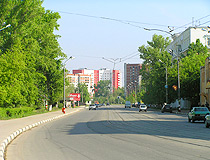
One sunny summer day in Nizhniy Novgorod
Author: Denis Plekhanov
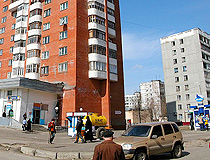
Apartment buildings in Nizhny Novgorod
Author: Eugene Ivanov
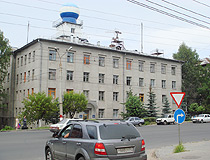
On the street in Nizhny Novgorod
Author: Sergey S. Kazenyuk
Nizhny Novgorod - Features
Nizhny Novgorod is located about 425 km east of Moscow, at the confluence of the two largest waterways of the European part of Russia - the Volga and Oka rivers. The city is divided by the Oka into two parts. The length of Nizhny Novgorod along the Oka is 20 km, along the Volga - about 30 km.
The climate in Nizhny Novgorod is moderately continental, with cold, long winters and warm, relatively short summers. The average temperature in January is minus 8.9 degrees Celsius, in July - plus 19.4 degrees Celsius.
A red deer is depicted on the coat of arms and flag of Nizhny Novgorod, which is a symbol of nobility, purity, life, wisdom, and justice. The City Day is celebrated on the 3rd Saturday in August.
In January 2019, Nizhny Novgorod was recognized as the best city in Russia in terms of quality of life. It took first place among Russian cities and 109th in the world in terms of quality of life. The rating was compiled by the site numbeo.com, which specializes in statistics on the cost of living and consumer prices in different countries of the world.
When compiling the rating, the purchasing power of the population, safety, health care, the cost of living, the ratio of real estate prices to the population’s income, traffic congestion, the level of environmental pollution, and climate were taken into account.
The main branches of the local industry are the production of cars and weapons, shipbuilding. Nizhny Novgorod is also one of the IT centers of Russia.
Nizhny Novgorod is a major transport hub. The city has a railway station, a river station, a cargo port, several berths for transshipment of goods. Strigino International Airport named after V.P. Chkalov offers regular flights to such cities as Yekaterinburg, Kazan, Kaliningrad, Moscow, Novosibirsk, Samara, St. Petersburg, Sochi, and a number of others.
Public transport in Nizhny Novgorod plays a very important role in ensuring the life of the city. At the same time, its work is hampered by the distribution of its population on the city’s territory, large daily migrations, a very high concentration of passenger traffic on the bridges across the Oka River, and the lack of an all-encompassing system of high-speed transport. There are municipal buses, fixed-route minibuses, trams, trolleybuses, the city train, and subway.
The tourist potential of Nizhny Novgorod is quite high. According to UNESCO, it is one of the most valuable historical cities in the world. In total, there are more than 600 unique historical, architectural and cultural monuments in Nizhny Novgorod, a variety of museums. The best time to visit Nizhny Novgorod is summer.
One of the alternative ways to visit Nizhny Novgorod is to take a river cruise along the Volga River. Travelers will find exciting excursions and meals in traditional Russian taverns. It will also be interesting to come during one of the many fairs or ethnographic festivals that are held in the city.
Main Attractions of Nizhny Novgorod
Nizhny Novgorod Kremlin (1508-1515) - a fortress in the historic center of Nizhny Novgorod and its oldest part, the main architectural complex of the city located on the right high bank, at the confluence of the Volga and Oka rivers. To date, all 13 towers of the Nizhny Novgorod Kremlin have been preserved or have been restored. The thickness of the wall at the base reaches 5 meters. There are exhibitions in the towers of the fortress; a section of the wall is open for tourists to visit.
In the past, there were several churches on the territory of the Nizhny Novgorod Kremlin. Today, only the Archangel Michael Cathedral has survived, built no later than the middle of the 16th century and rebuilt in 1628-1631 - the oldest surviving building in the kremlin. There is the grave of Kuzma Minin inside it.
An excellent view of the Volga River and Strelka (the confluence of the Oka and Volga) opens from the walls of the Nizhny Novgorod Kremlin. Here you can also see a collection of military equipment from the Second World War.
Nizhny Novgorod State Art Museum - one of the oldest museums in Russia, the largest museum of fine arts in the Nizhny Novgorod region. The Governor’s Palace on the territory of the Nizhny Novgorod Kremlin houses a permanent exhibition of Russian art and a collection of artistic silver.
In the House of the Merchant and Benefactor D.V. Sirotkin (Verkhnevolzhskaya Embankment, 3), an exposition of Western European art is presented and, separately, the painting by K.E. Makovsky “The appeal of Kuzma Minin to the citizens of Nizhny Novgorod” - one of the largest paintings on a historical theme in Russia (698x594 cm).
Chkalov Stairs (1943-1949) - a monumental staircase in the form of a figure eight in the historic center of Nizhny Novgorod. Connecting the Upper Volga (Verkhnevolzhskaya) and Lower Volga (Nizhnevolzhskaya) embankments, it is one of the longest stairs in Russia. It starts from the observation deck at the monument to Valery Chkalov (the famous Soviet pilot who made the first non-stop flight from the USSR to the USA via the North Pole), next to the St. George Tower of the Nizhny Novgorod Kremlin.
Bolshaya Pokrovskaya Street - the main street of Nizhny Novgorod built up with noble mansions of the past centuries. A large part of Bolshaya Pokrovskaya is reserved for the pedestrian zone and is analogous to the pedestrian Arbat Street in Moscow. There are a lot of historic houses, cafes, souvenir shops, boutiques, monuments, and sculptures here. The length of the street is over 2 km.
The building of the State Bank (Bolshaya Pokrovskaya Street, 26), resembling a medieval palace, is an outstanding architectural monument built in the Russian Revival style in 1911-1913. In the Museum of Old Equipment and Tools (Bolshaya Pokrovskaya Street, 43), you can see unique exhibits, hear their history, and even touch them.
Fedorovsky Embankment - one of the most beautiful embankments in Nizhny Novgorod and the best observation deck in the city. Everything is perfectly visible from this embankment: the old part of the city, the river station with a park, the Kanavinsky bridge - one of the oldest in the city, and, of course, the opposite bank of the Oka River with the Alexander Nevsky Cathedral, the confluence of the Oka and Volga. People also come here to watch the sunset.
Nizhny Novgorod Volga Aerial Tramway. This cable car, 3661 meters long, connects the high right bank of the Volga River, where the historic part of Nizhny Novgorod is located, with the town of Bor. It has the largest unsupported span over the water surface in Europe - 861 meters.
A one way trip during which you can admire the picturesque views of Nizhny Novgorod and the Volga River takes 15 minutes. It is better to use it in good sunny weather, because in windy weather, the movement of the cabins can be stopped. Sennaya Square on Kazanskaya Embankment.
Nizhny Novgorod State Museum of History and Architecture (1875-1877). Also known as the Mansion of S.M. Rukavishnikov, it is an architectural ensemble built in the eclectic style in the historic center of Nizhny Novgorod, one of the most important and famous architectural monuments of this city. Guided tours are held in the premises, allowing you to learn about the life of the former owners of the mansion, as well as look at the historical expositions of different years. Verkhnevolzhskaya Embankment, 7.
Main Palace of Nizhny Novgorod Fair - a luxurious building constructed in the forms of Old Russian architecture of the 17th century. Today, exhibitions of various formats are held here, as well as the multimedia exposition “Russia - my history” dedicated mainly to the history of Nizhny Novgorod starting from the Finno-Ugric peoples. Sovnarkomovskaya Street, 13.
Museum of the History of the Gorky Automobile Plant. The museum houses expositions telling about the history and development of the Gorky Automobile Plant. In total, there are over 40,000 exhibits. Here you can see a collection of Soviet vintage cars, which includes “Chaika”, “Volga”, the truck “GAZ-51”, and a lot of others. Lenina Avenue, 95.
Alexander Nevsky Cathedral (1868-1881) - the most noticeable sight of the lower part of Nizhny Novgorod, which can be seen from all observation decks of the upper city. The church, 87 meters high, was built on the site of the Nizhny Novgorod Fair at the expense of merchants, who wanted to perpetuate the visit of Emperor Alexander II. Strelka Street, 3a.
Church of the Nativity of the Blessed Virgin Mary (1696-1719) - one of the best examples of the Stroganov Baroque, an architectural monument of federal significance. From a distance, this colorful building looks like a sugar gingerbread with “candy” domes and decorated with stone flowers, pears and apples. Rozhdestvenskaya Street, 34.
Pechersky Ascension Monastery - one of the most interesting places in Nizhny Novgorod, where you can feel the spirit of the city. Most of the monastery buildings date back to the first half of the 17th century. A lot of beautiful photographs can be taken here. Privolzhskaya Sloboda Street, 108.
Limpopo Zoo - the first private zoo in Russia. More than 270 species of animals live here, 25 of which are listed in the Red Book of the Russian Federation. It is located on the territory of the Sormovsky Park on an area of 7.1 hectares. Yaroshenko Street, 7b.
Architectural and Ethnographic Museum-Reserve “Shcholokovskiy Khutor”. The exposition of this museum is represented by 16 objects of rural architecture: residential houses, barns, mills and churches of the 17th-19th centuries brought from the northern districts of the Nizhny Novgorod region. The facades of the houses are decorated with traditional relief carvings. In the premises of the houses, interiors with authentic items of peasant life have been restored. Gorbatovskaya Street, 41.


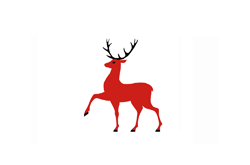
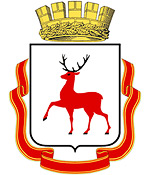
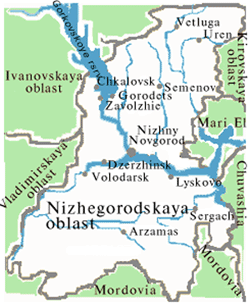



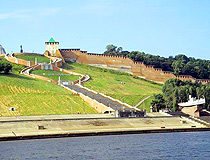
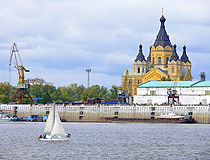
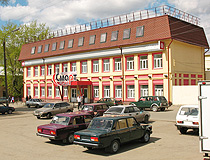
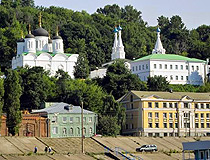
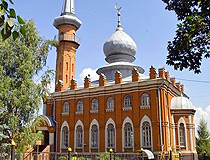
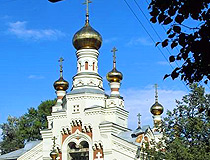
The comments of our visitors